Chicken and leek risotto is an easy one-pot meal to make that’s loaded with vegetables and plenty of punchy flavour. It can be on the table in 45 minutes, if not sooner, and there’s minimal washing-up.
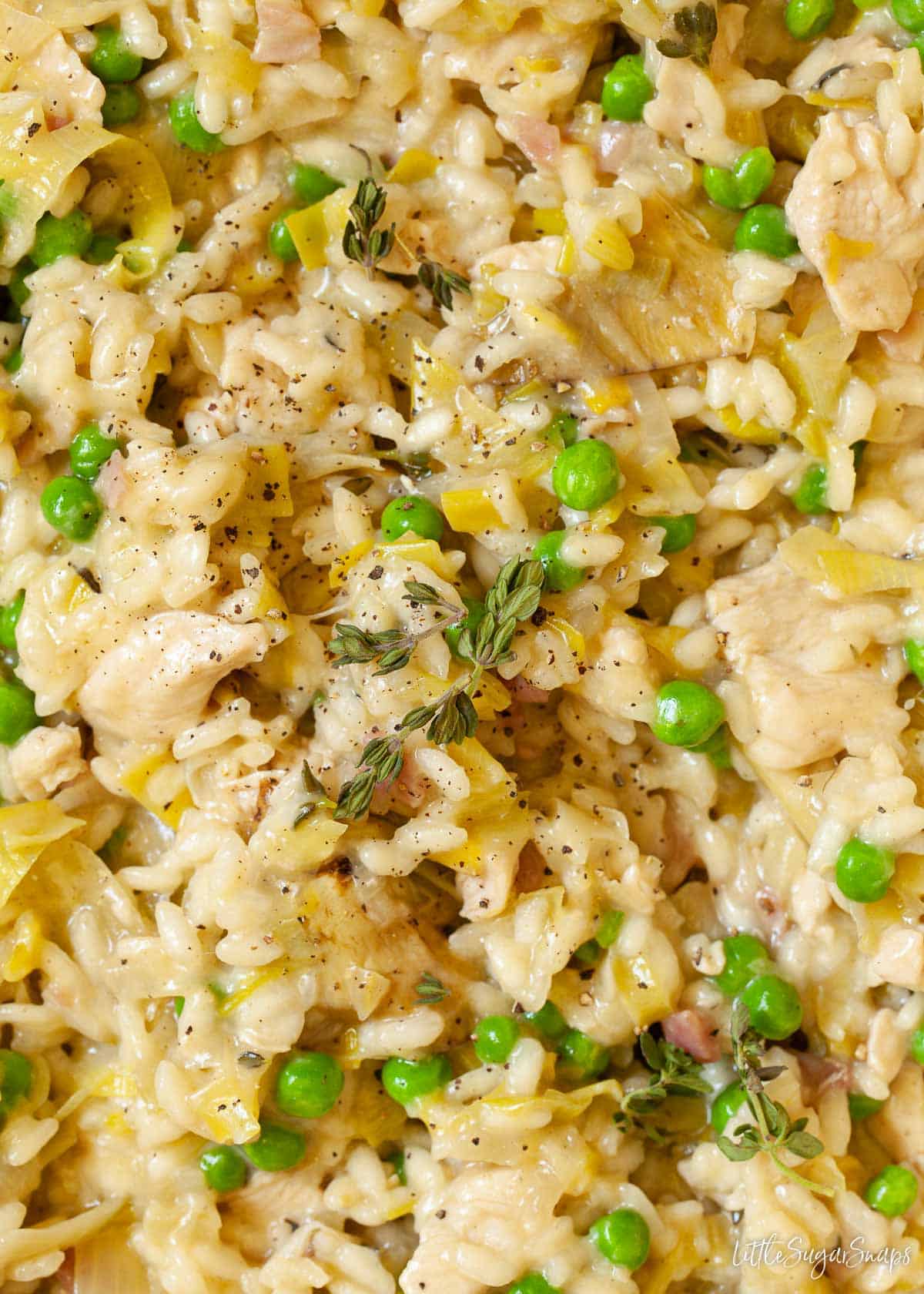
Chicken and leek risotto is a simple and gratifying meal that’s loaded with healthy vegetables. This easy risotto recipe comes flavoured with chicken, leeks, bacon, peas, artichoke and an abundance of parmesan cheese.
It’s true that risotto needs time and attention when being cooked, so maybe it’s a more high maintenance dinner option than some. But on the plus side, risotto makes very little in the way of dirty dishes.
So pop on your favourite tunes and while away some time stirring away in the kitchen. Then serve up this creamy leek risotto with a well-deserved glass of white wine, safe in the knowledge that cleaning up will take mere minutes.
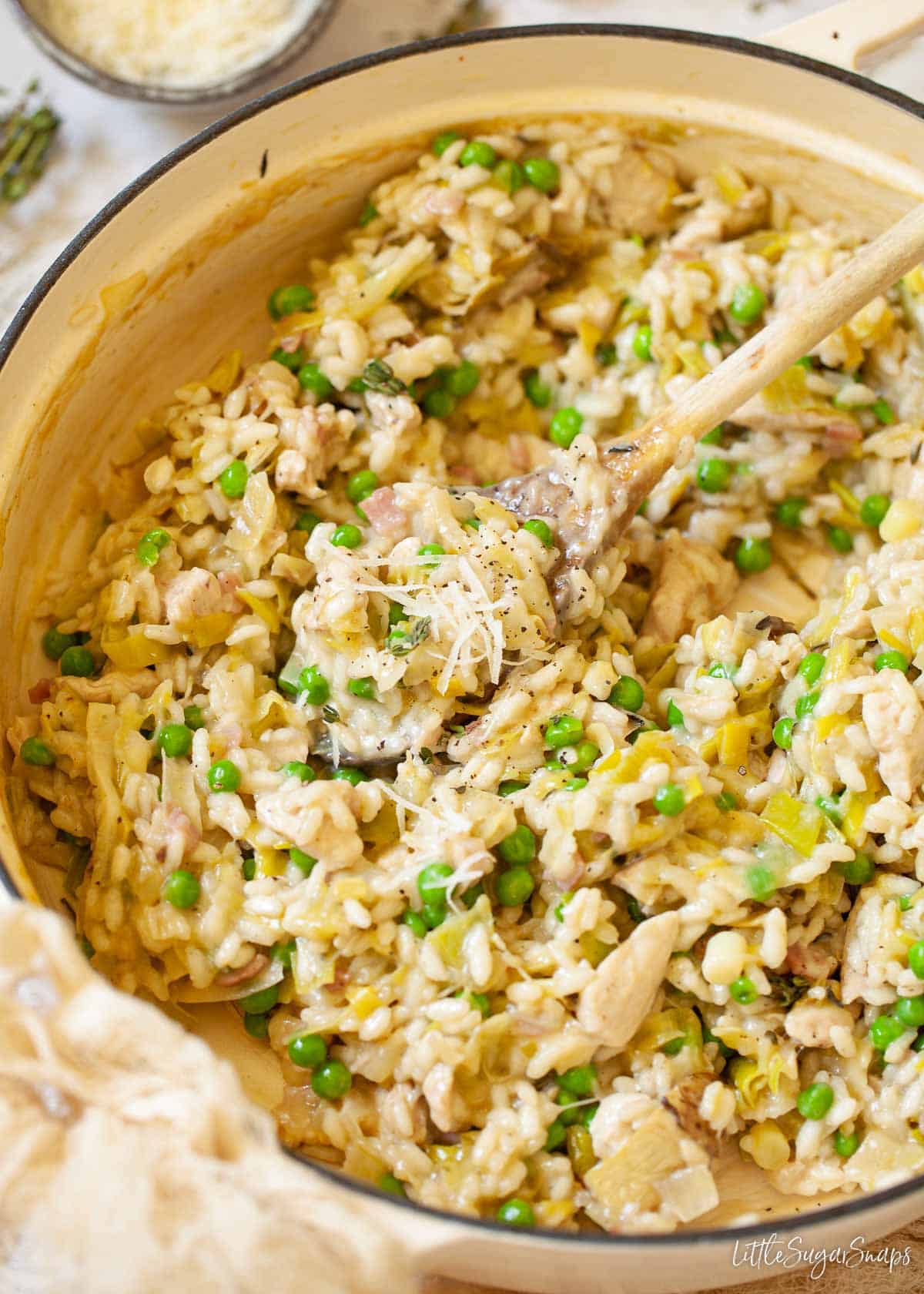
Why stovetop risotto is worth the effort
I can think of so many reasons why this chicken and leek risotto should feature regularly on your dinner table:
- It’s a one-pan meal so there’s minimal washing-up (hoorah).
- The result is a deeply delicious, creamy and comforting meal.
- A little chicken goes a long way in this recipe, so it’s great if you’re trying to reduce your meat intake (and of course, this also makes it purse-friendly).
- The recipe can easily be halved to make a risotto for 2.
- It’s easy and relatively quick – the meal can be on the table in 45 minutes, if not sooner.
- The base recipe is simple to tweak for variation – I’ve included plenty of ideas towards the bottom of this post.
You might also enjoy my pea and bacon risotto, but if you just don’t have time for all that stirring then you can always try my super-speedy mushroom fried rice.
The best rice for risotto
Risotto should always be made with a high starch medium-short grain rice. There are a number of varieties available:
- Arborio
- Carnaroli
- Baldo
- Maratelli
- Padano
- Roma
- Vialone Nano
These rice varieties all have the ability to absorb liquids and release starch so they are stickier than long grain varieties. Each variety has slightly different qualities though. Specifically, some will result in a creamier finish to a risotto than others. For this creamy chicken and leek risotto recipe stick with Arborio or Carnoroli.
When making risotto the rice should never be rinsed. As in all risotto recipes, we need the starch to ensure that signature creamy finish to this chicken and leek risotto.
Ingredients and equipment notes
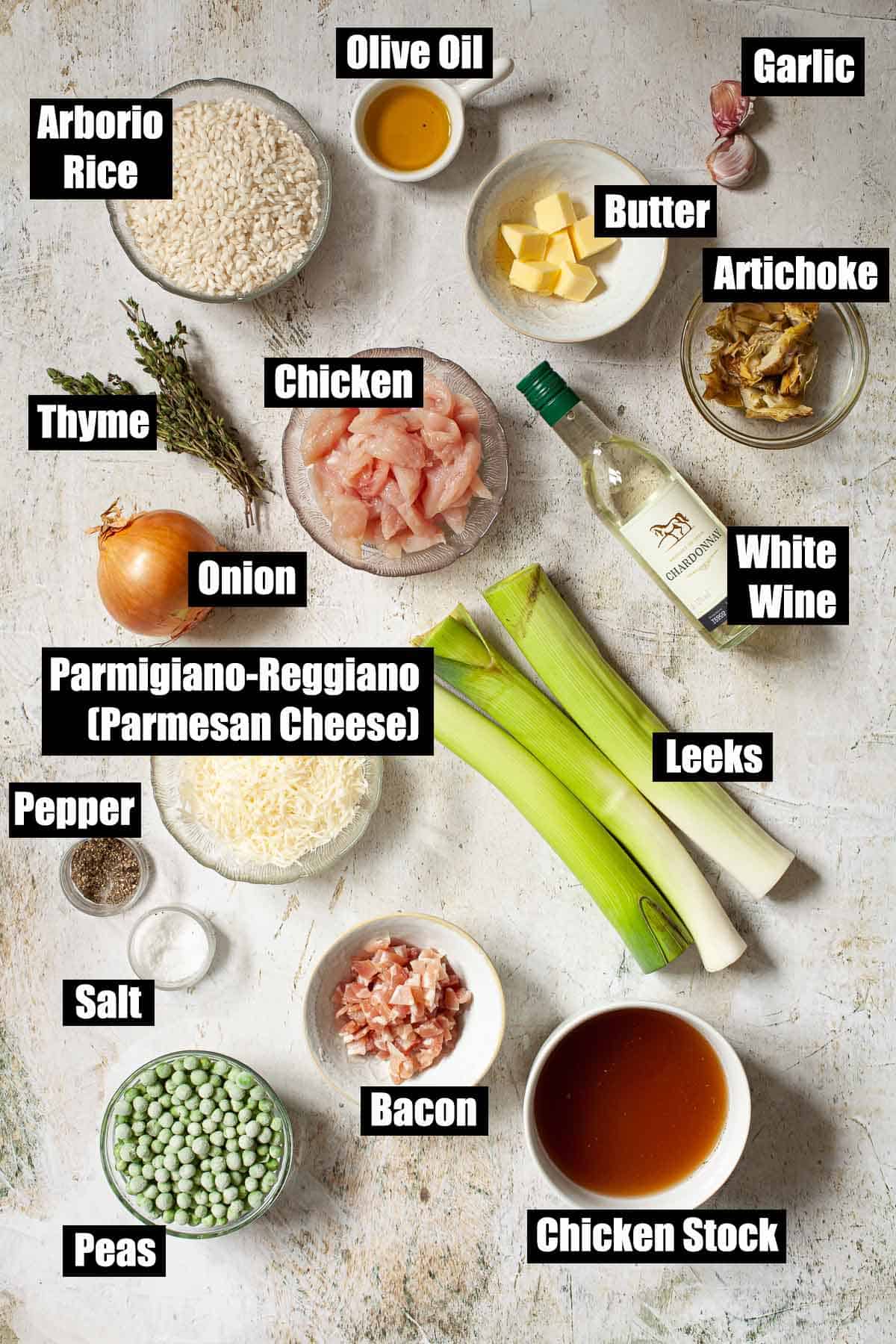
Leeks are clearly an integral part of this creamy stovetop risotto recipe. It’s up to you how to chop them – I personally like to slice them into rings but you can chop them finer if preferred.
I’ve used Arborio rice as it’s easy to pick up in the supermarket and lends itself to creating a deliciously creamy leek risotto. Carnaroli would be a good choice too.
Although I’ve used raw chicken here this can be replaced with cooked chicken. Just add it in at the same time as the peas to warm though. If using raw chicken, opt for skinless and boneless breast meat so it is easy to slice.
Stock can vary wildly in terms of salt levels. For this reason, take a taste before adding any to the rice. If it’s excessively salty consider watering it down. Similarly, it’s wise to add any additional salt once cooking is complete. Have a taste then add in enough extra salt to suit your own preference level.
White wine helps build a great flavour profile. If you don’t have any to hand then dry Vermouth is a reasonable alternative. Since all of the alcohol burns away during cooking, this chicken and leek risotto is safe to serve to children even though it contains wine. It won’t get them tipsy!
Fresh thyme is optional but recommended. Dried thyme or even mixed herbs work well as a second best alternative.
Parmigiano-Reggiano (aka parmesan) is the best cheese to use in this leek risotto to ensure great flavour and a rich, creamy and indulgently comforting consistency. Grana Padano is a good alternative.
Use a heavy-based large pan so there is plenty of room for the rice as it cooks. This helps ensure that it cooks evenly and makes stirring much easier than when everything is crowded into a pan that is barely big enough.
Step-by-step instructions
- Slice the leeks, dice the onion, chop the bacon and mince the garlic.
- Fry the onions, leeks, bacon and garlic for 5 minutes until beginning to soften.
- Dice the chicken add to the pan and cook until sealed on all sides.
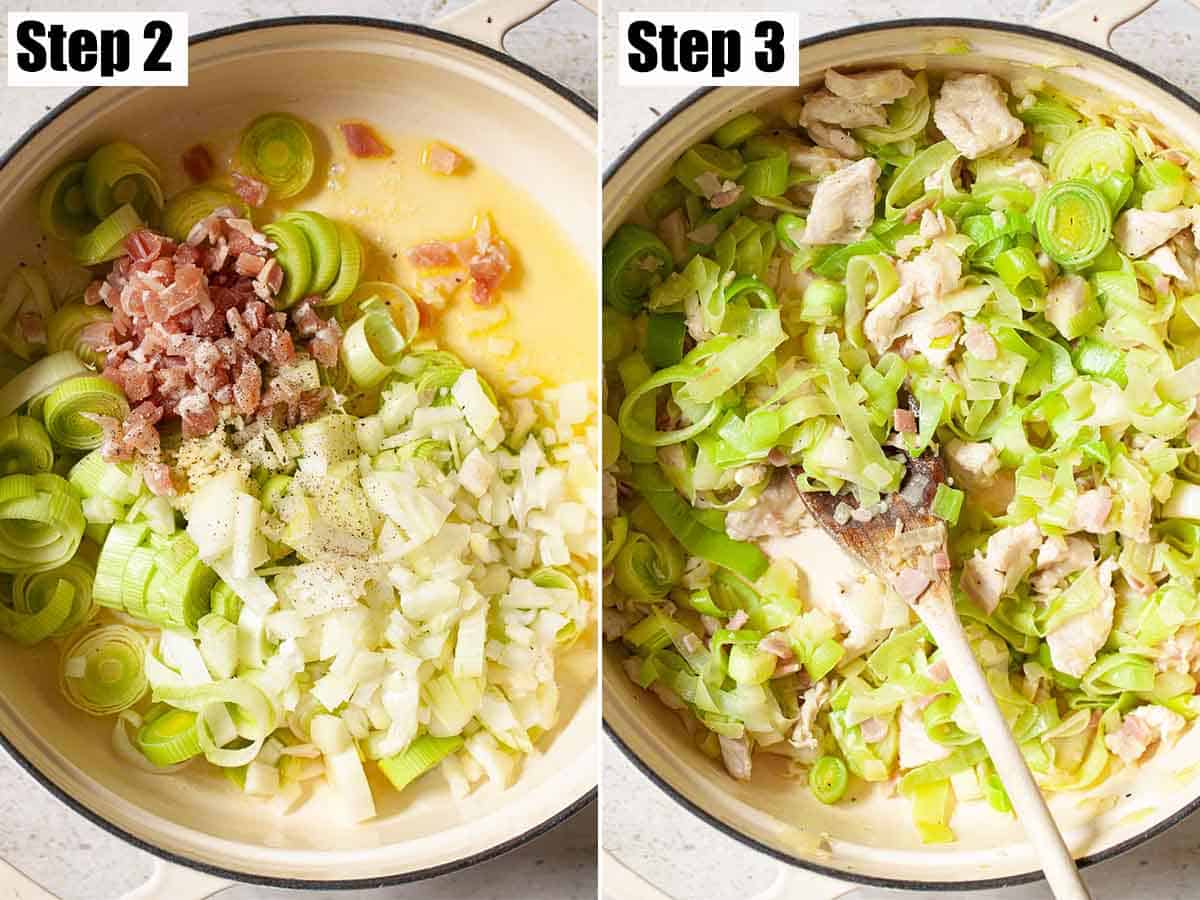
- Add the rice and black pepper, let cook for several minutes, stirring.
- Add the wine to the pan, stir and let the liquid evaporate.
- Toss the thyme into the pan.
- Add the stock, a little at a time, stirring well between each addition. After 20 minutes test the rice to see how well it is cooking. If it is still firm keep adding a bit more stock. If it feels almost ready then move on to the next step.
- When the rice is almost cooked add a little more stock along with the peas and artichokes. Test the rice again after 5 minutes. It is ready when it feels al-dente (there’s still a little bite to the rice but, essentially, it doesn’t feel firm or chewy).
- Turn off the heat, remove any large stems of thyme, add grated Parmegiano-Reggiano and the remaining butter, cover the pan with a lid and let the risotto sit for 5 minutes.
- Season with salt to taste. Stir well before plating up.
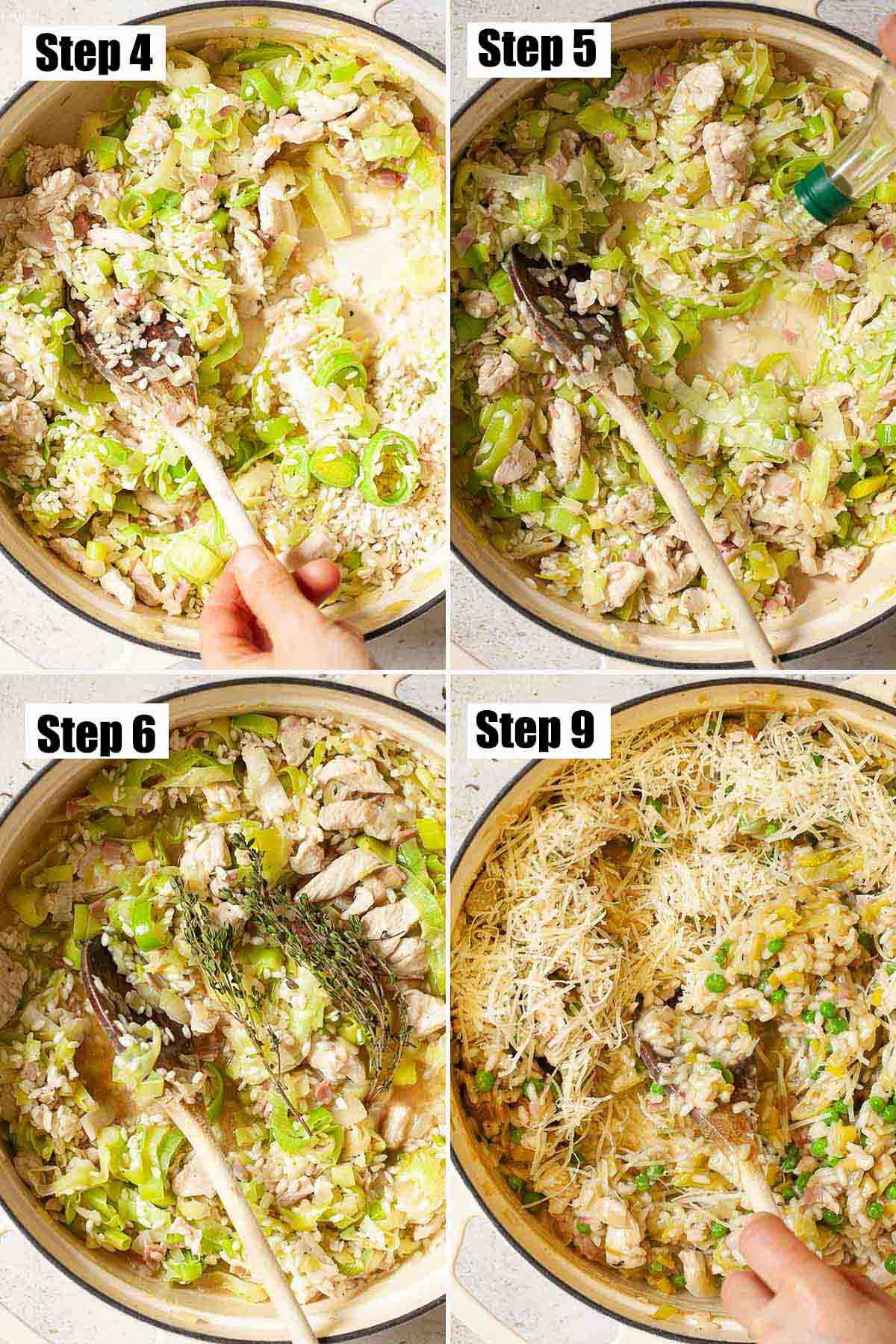
Expert tips
- Don’t underestimate the power of stirring. It’s essential to keep the risotto frequently on the move to help prevent it sticking to the pan and to help create that legendary creamy risotto consistency.
- Keep your stock hot – this will reduce the cooking time considerably. It’s a good idea to pop the stock into a pan and keep it on a low heat as the risotto cooks.
- Regular tasting will help you ascertain when the rice is cooked enough.
- Tasting will also help you gauge how much additional seasoning is needed.
- This chicken and leek risotto is best served fresh. The longer it sits, the more the rice will continue to absorb liquid causing the consistency of the risotto to deteriorate.
Frequently asked questions
Technically, the answer is yes, this leek risotto can be stored in the fridge and it can frozen. But every bone in my body wants to scream out loud that reheated risotto is a far cry from the soft and creamy mound of deliciousness that it is when served fresh.
So my advice is don’t plan for leftovers. Don’t make more than you know you’ll need – cut the recipe down if necessary. Risotto continues to absorb liquid as it sits, so becomes more solid and the rice a little mushier, as a result. Yes, reheated risotto is edible but it’s definitely past its prime.
If, however, you are faced with leftovers then they can be stored in the fridge for up to 48 hours and frozen for up to 3 months. Defrost thoroughly and reheat (on the stovetop or in a microwave) until piping hot, adding a splash of water to loosen the consistency.
Yes, you can. I always advocate the stovetop method with plenty of stirring to get the best textured risotto going, but as a push, you can drop things into a slow-cooker and leave it to simmer away for several hours.
You’ll need to follow steps 1-6 then transfer to the slow cooker pan along with ¾ of the stock. Cook on high for 1 ½ hours then add the peas and artichokes plus any further stock that is needed and cook for a further 15-30 minutes. Check the rice is cooked before mixing in the cheese and butter.
Again, this chicken and leek risotto could be oven-baked but the texture of the rice will not be as good.
Follow the instructions given above for cooking in a slow cooker, but place the ingredients in a large oven-proof pot greased well with butter. Cover with foil and bake at 180C/ 350F/ GM 6 for 30 minutes, stirring halfway. Toss in the peas and artichokes, plus more stock as necessary, re-cover and cook for another 10 minutes. Check the rice is cooked before mixing in the cheese and butter.
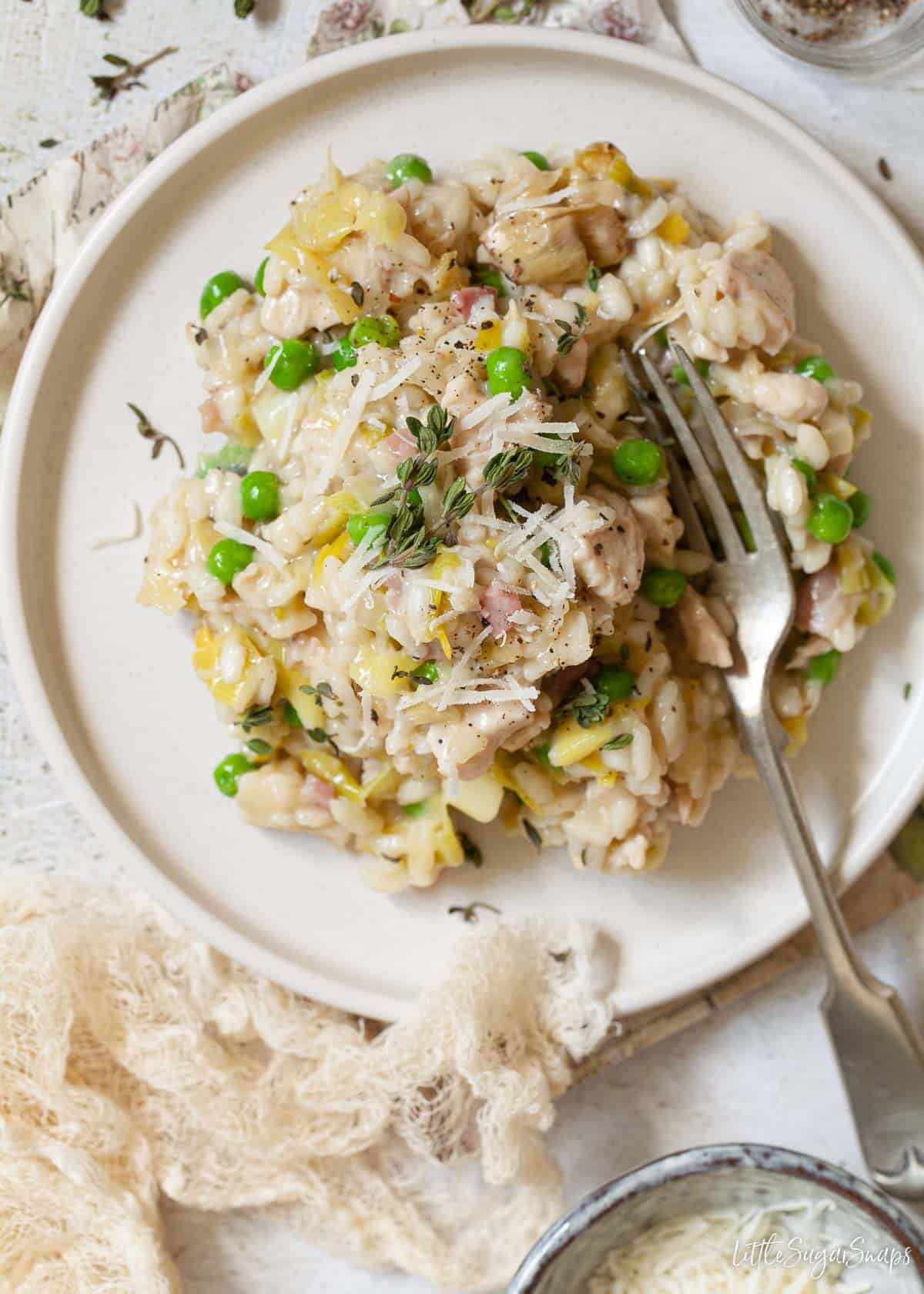
How to make this leek risotto vegetarian
There are 4 ingredients to address when turning this chicken and leek risotto into a vegetarian meal:
- Chicken – replace it with chunky vegetables such as chestnut mushrooms or sliced courgette.
- Bacon – something with a salty edge to it such as olives or sundred tomatoes makes the best substitute.
- Chicken stock – simply swap it for vegetable stock.
- Parmegiano-Reggiano (parmesan cheese) is not vegetarian as it is made using animal rennet – so you’ll need to swap to a veggie-friendly hard cheese. Some supermarkets sell an Italian-style hard cheese very similar to parmesan that is vegetarian, so look out for this. Alternatively, buck the trend completely and swap to blue cheese such as stilton (but not Gorgonzola as this is also not vegetarian).
And if you’re hankering after a vegan leek risotto, make the first 3 substitutions above and swap the cheese for 3-4 tablespoons of nutritional yeast. Don’t forget to check that the white wine is vegan as some are not.
Variations
- Fry some mushrooms in step 2
- Toss a couple of handfuls of fresh spinach leaves in at the same time as the cheese. The spinach will wilt and add a lovely burst of colour as well as providing a nutritional boost.
- Omit the artichokes.
- Add a burst of intense and tangy flavour using sundried tomatoes – chop 3-4 finely and stir through at the end.
- Leave the chicken out and serve with grilled salmon fillets on the top instead.
- Alternatively, add in some prawns in step 8 and allow to cook through.
More Italian recipes to try




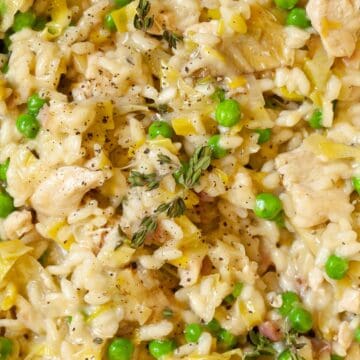
Chicken and Leek Risotto
Equipment
- 1 Large heavy-based pan
Ingredients
- 450 g Leeks, trimmed approx 3 leeks
- 1 Onion
- 2 Garlic cloves
- 1 tablespoon Olive oil
- 30 g Butter
- 60 g Bacon
- 300 g Chicken breast skinless and boneless, free-range
- 300 g Arborio rice Baldo, Carnaroli, Maratelli, Padano, Roma, and Vialone Nano are all good substitutes
- 100 ml White wine
- 10 g Fresh thyme
- 1 litre Chicken stock hot
- 150 g Peas frozen or fresh
- 75 g Parmigiano-Reggiano (parmesan cheese)
- 4 Marinated artichokes drained from preserving oil
- ¼ teaspoon Black pepper
- Salt to taste
Instructions
- Begin by slicing the leeks, finely dicing the onion, cutting the bacon into small pieces and mincing the garlic.
- Add the oil and half of the butter to a large heavy-based pan and fry the onions, leeks, bacon and garlic for 5 minutes until the vegetables begin to soften until beginning to soften.
- Dice the chicken and toss into the pan. Cook, stirring frequently until sealed on all sides.
- Pour the rice and black pepper into the pan and stir to coat in oil. Let cook for a minute, stir and let cook for another minute.
- Add the wine to the pan, give everything a good stir and then let the liquid evaporate.
- Toss the thyme into the pan.
- Now start adding the stock, a ladleful (75ml) at a time, stirring between each addition until it is absorbed. After 20 minutes test the rice to see how well it is cooking. If it is still firm keep adding a bit more stock. If it feels almost ready then move on to the next step.
- When the rice is almost cooked add a little more stock along with the peas and artichokes. Test the rice again after 5 minutes. It is ready when it feels al-dente (there's still a little bite to the rice but, essentially, it doesn't feel firm or chewy)
- Take the pan off the heat, remove any large stems of thyme, stir in the Parmegiano-Reggiano and the remaining butter, cover the pan with a lid and let the risotto sit for 5 minutes. Season with salt to taste. Stir well before plating up.
Notes
- Don’t underestimate the power of stirring. It’s essential to keep the risotto frequently on the move to help prevent it sticking to the pan and to help create that legendary creamy risotto consistency.
- Keep your stock hot – this will reduce the cooking time considerably. It’s a good idea to pop the stock into a pan and keep it on a low heat as the risotto cooks.
- Regular tasting will help you ascertain when the rice is cooked enough.
- Tasting will also help you gauge how much additional seasoning is needed.
- This chicken and leek risotto is best served fresh. The longer it sits, the more the rice will continue to absorb liquid causing the consistency of the risotto to deteriorate.




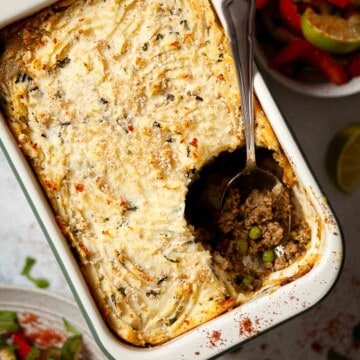
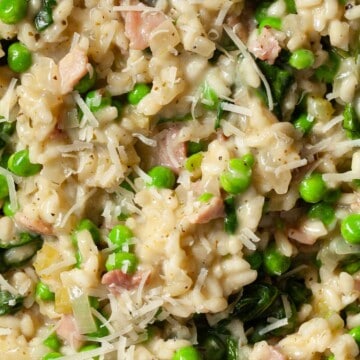
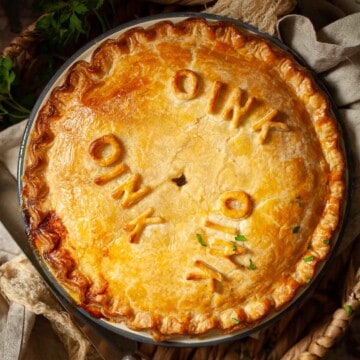
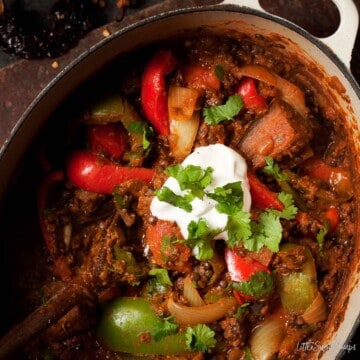
Leave a Reply